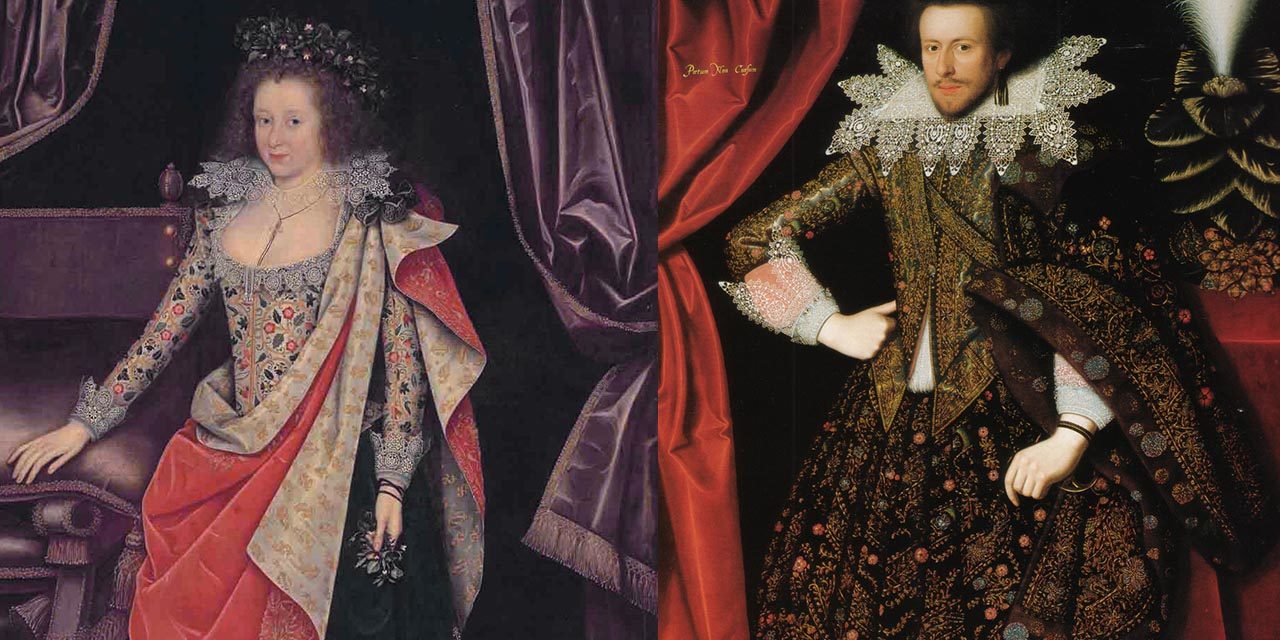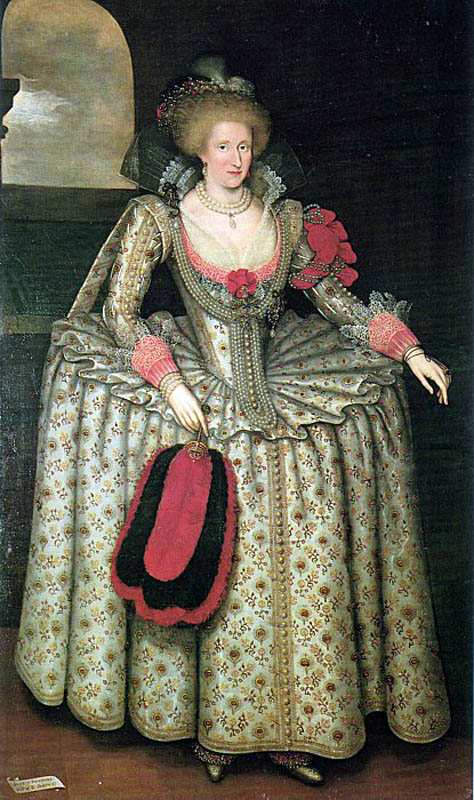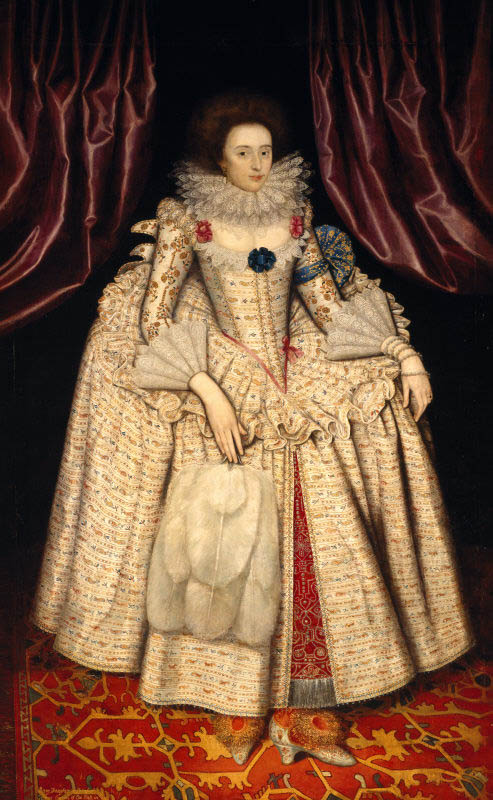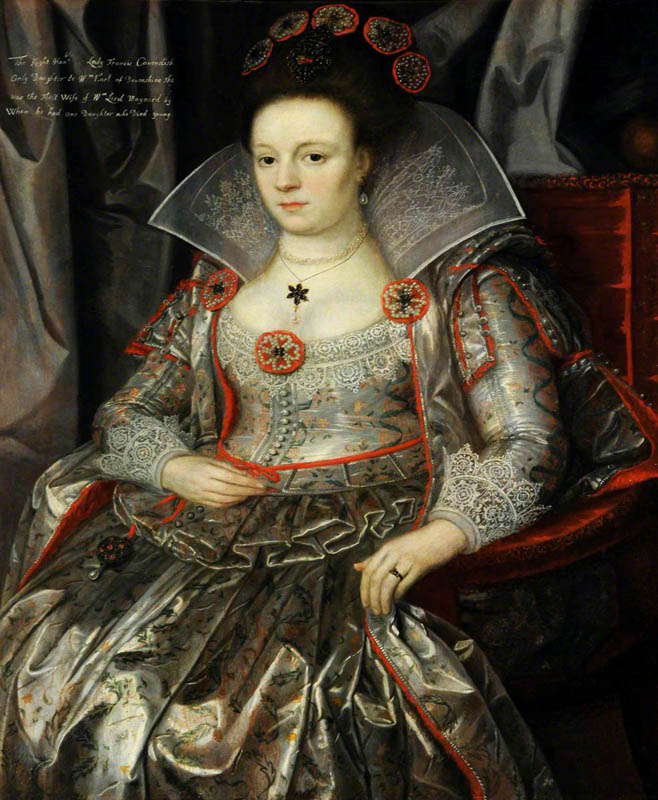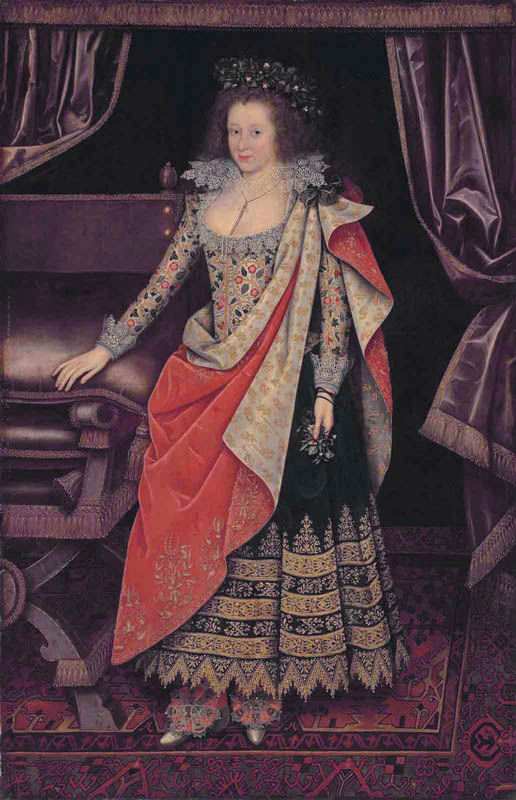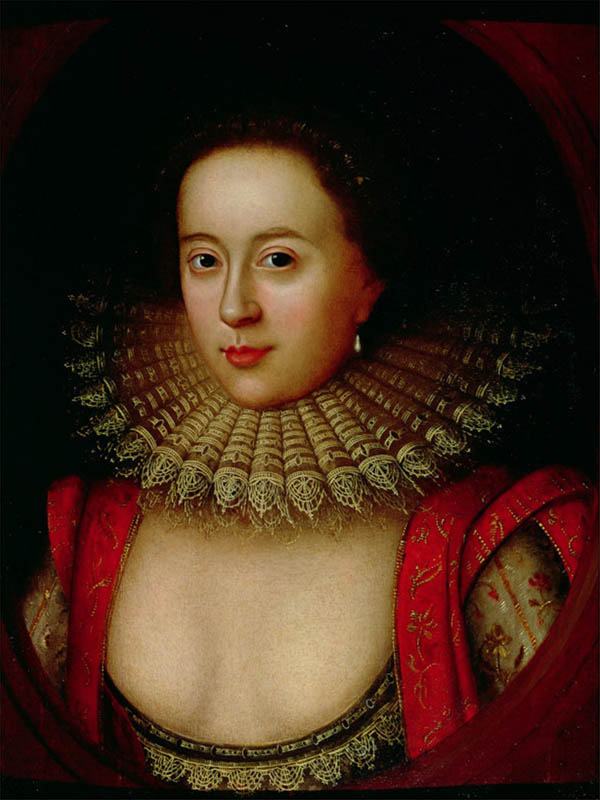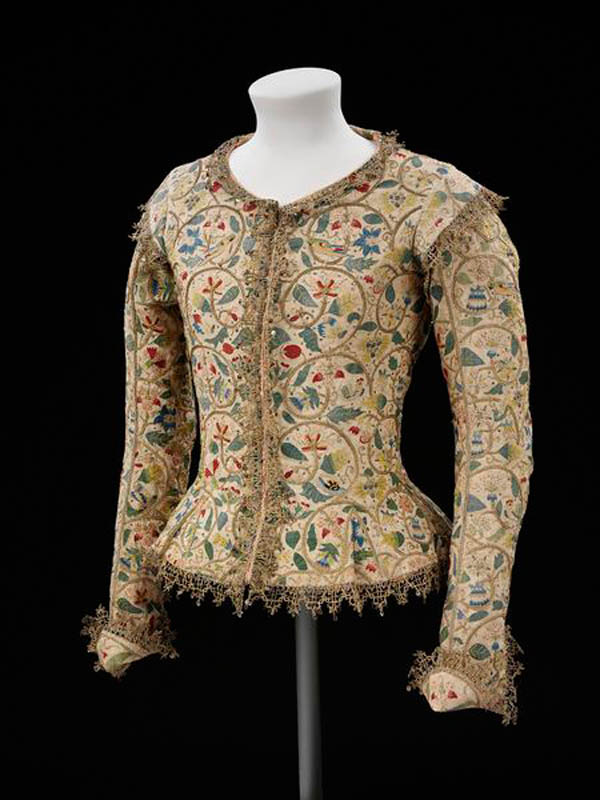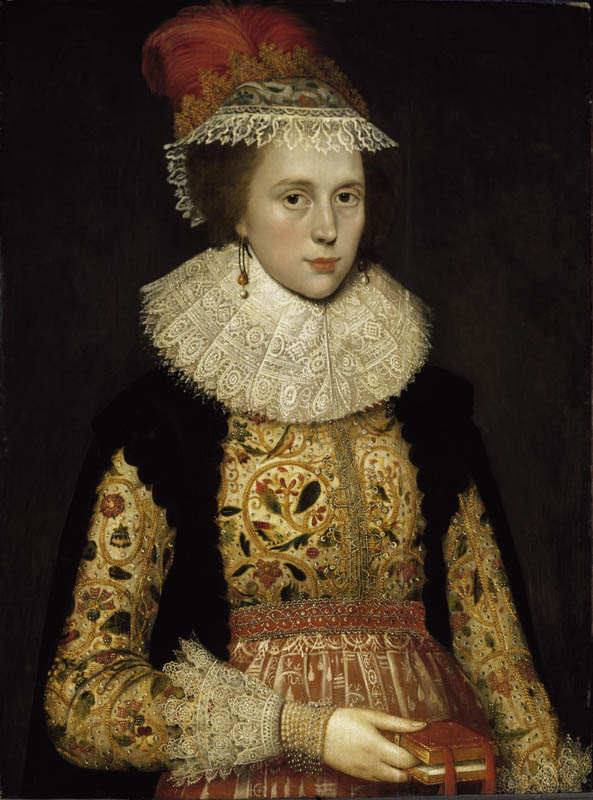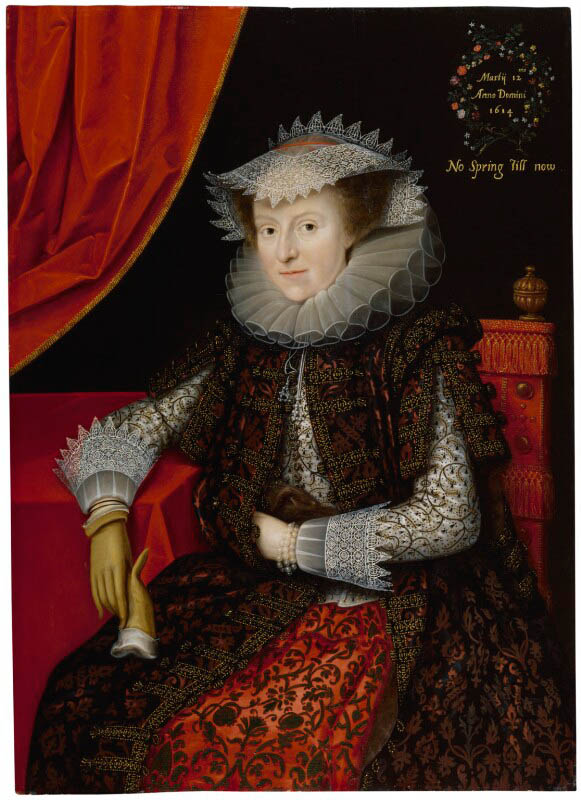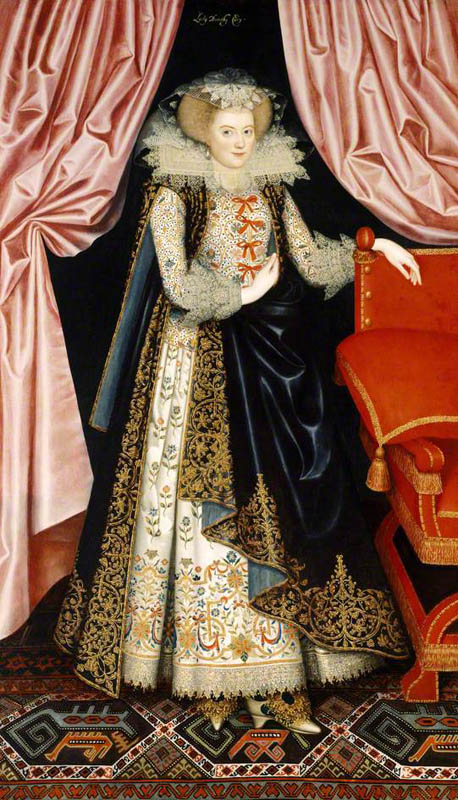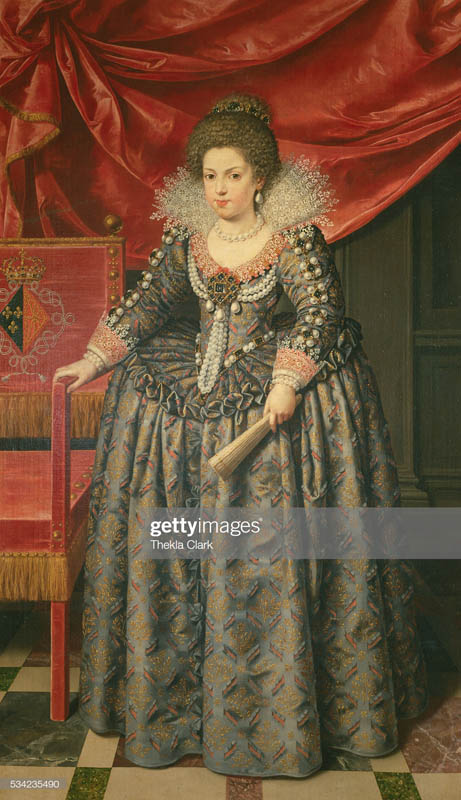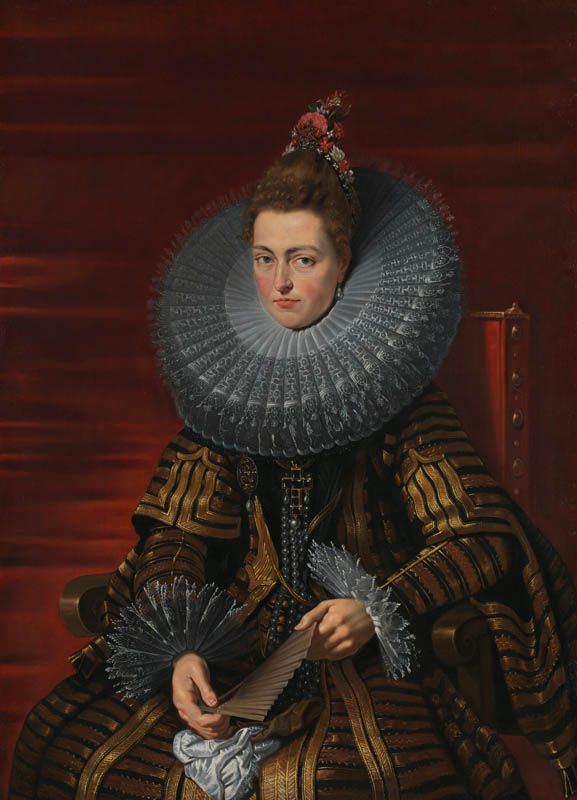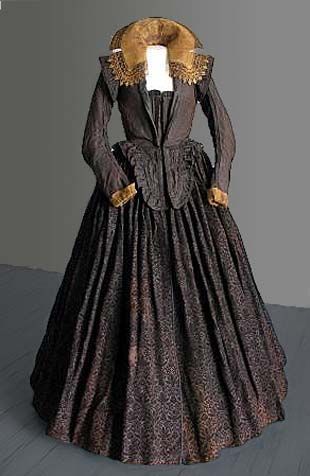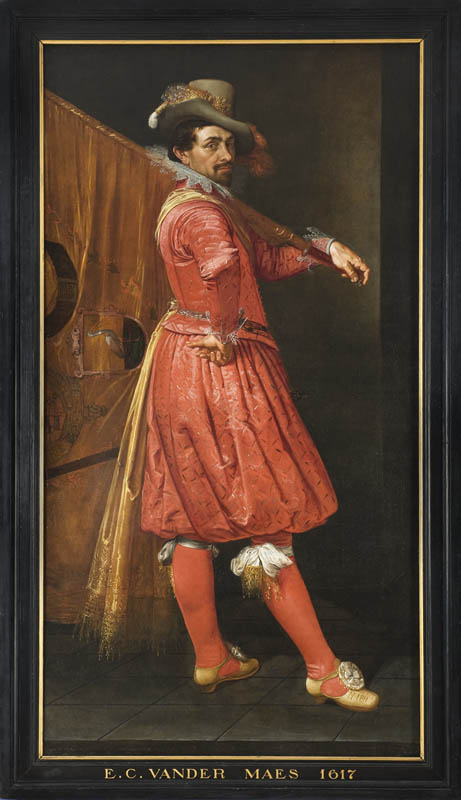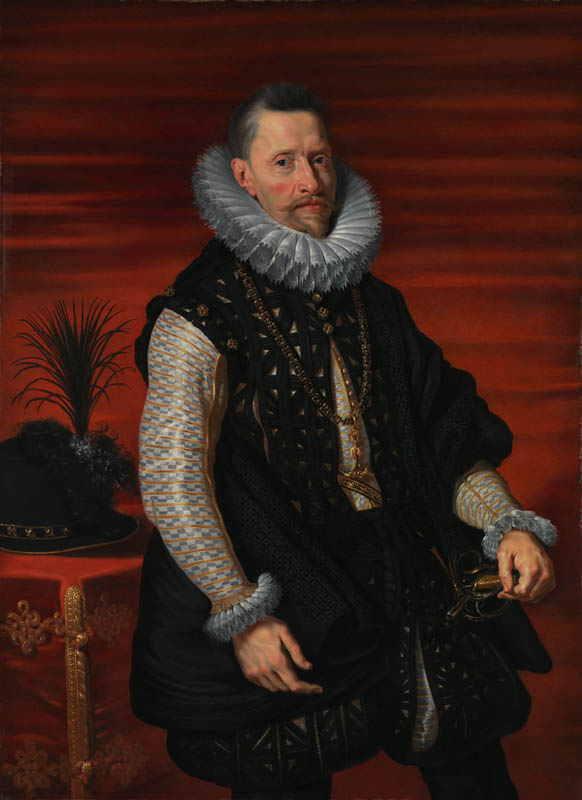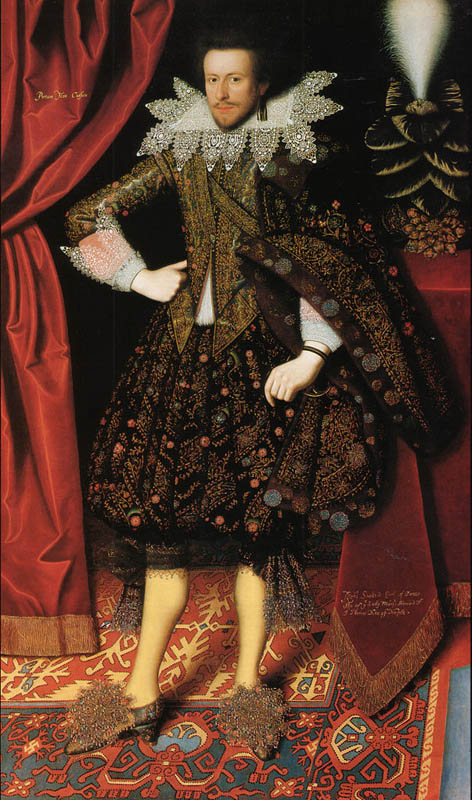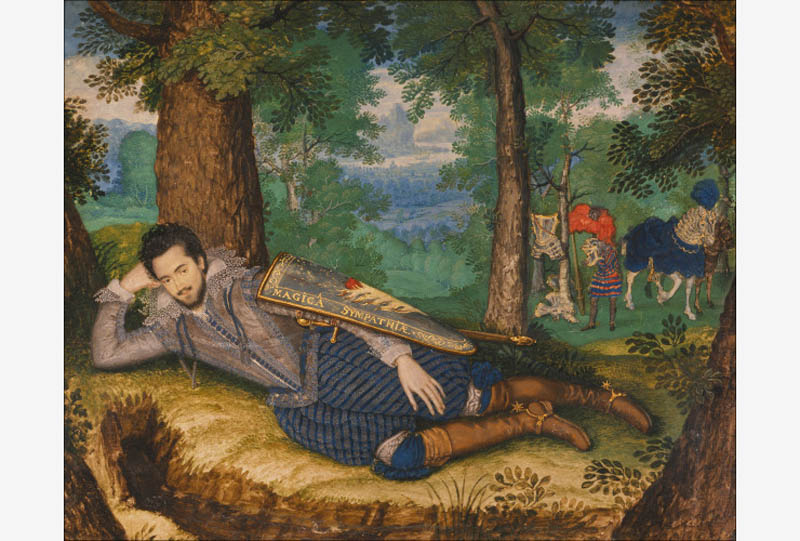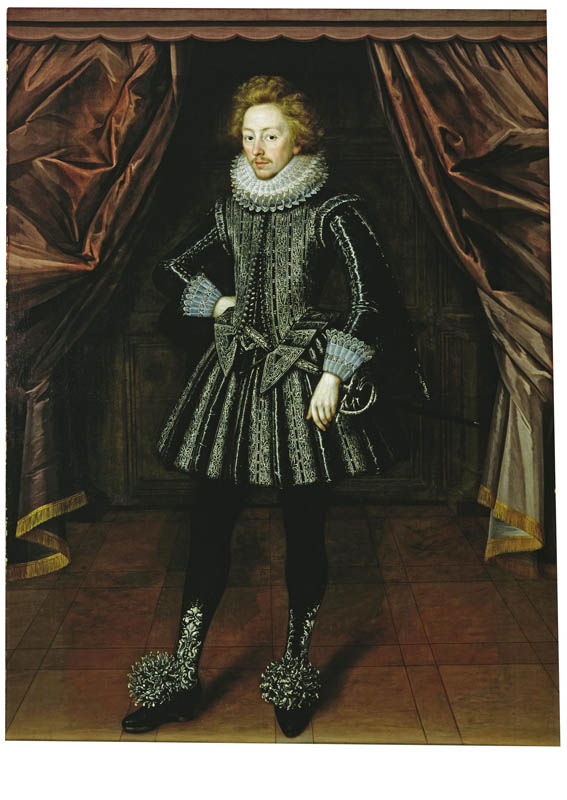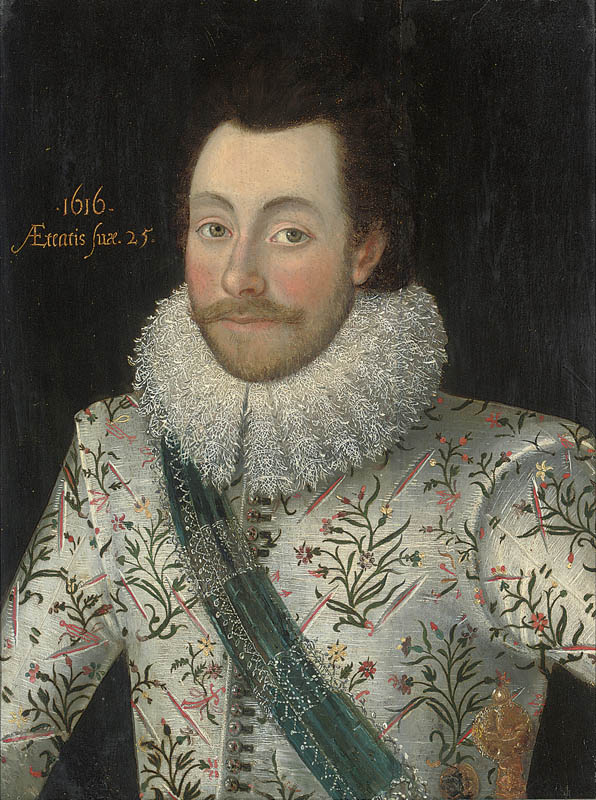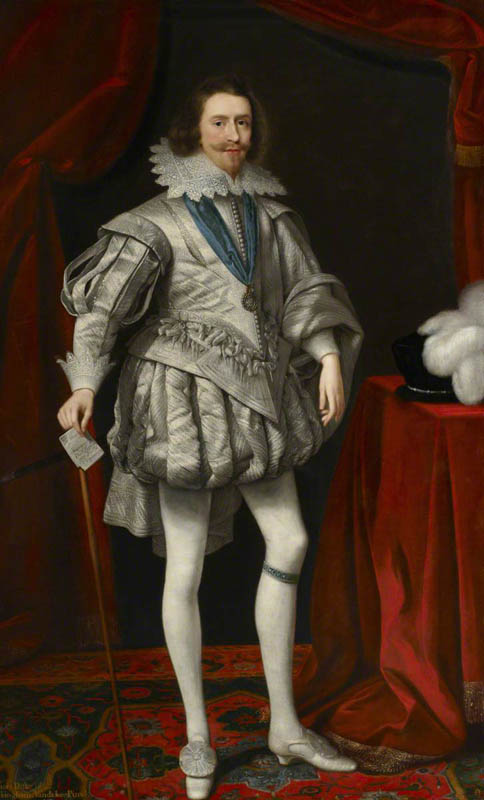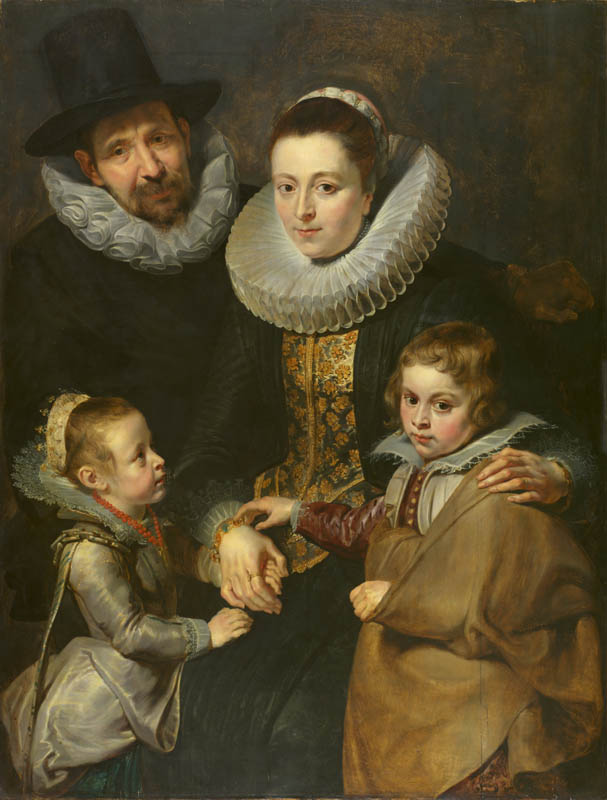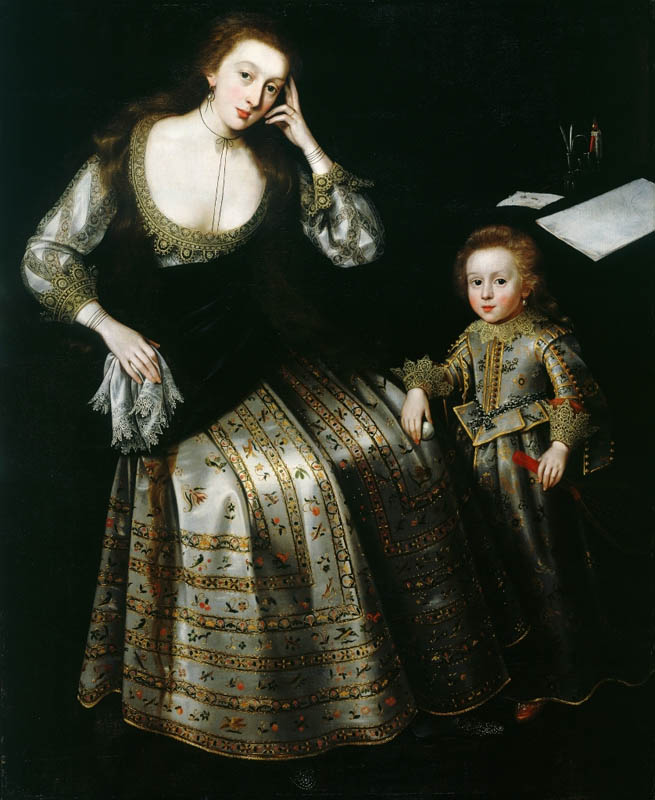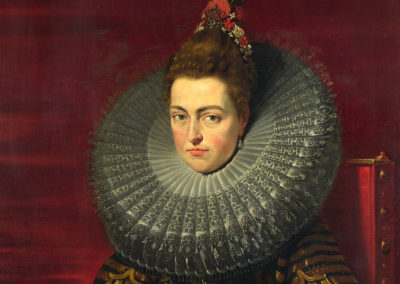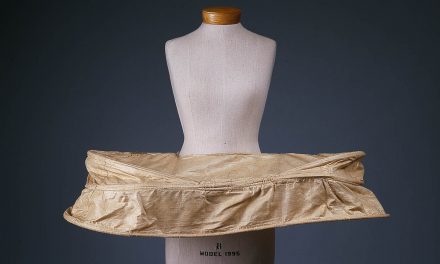OVERVIEW
Fashion of the 1610s witnessed a gradual softening in the silhouette as women began to discard their farthingales and men’s breeches became baggier.
Womenswear
Lady Catherine Smythe Scott (Fig. 1) shows the standard fashion of 1610 in her portrait: long narrow dress bodice with tight cylindrical sleeves and vestigial hanging sleeves behind, a low rounded neckline and lace standing collar. The drum shape of her skirt is created by the French farthingale she wears below it, the top edge of the now tilted cage is softened by an elaborately pinned ruffled top. The skirt has shortened such that her shoes are visible. Her dress continues trends of the previous decade.
Similar fashions can be seen on Anne of Denmark, Queen Consort of England, in a portrait circa 1611-14 (Fig. 2). Here her lace cuffs are made more visible by the contrasting carnation color beneath them; she has an enormous red velvet rosette tied to her left upper arm and carries a dramatic red and black ostrich feather fan. As Valerie Cumming remarks in her Visual History of Costume: The Seventeenth Century (1984): “The false hanging sleeves extend the shoulder line, and the small waist is emphasized by the wide oval neckline and tip-tilted fullness of the farthingale; both bodice and skirt are made from Italian brocaded silk. The décolletage is masked by fine linen.” (24)
Mary Curzon, Countess of Dorset, takes the fashions perhaps even further in her portrait (Fig. 3), where her overskirt is parted to reveal a red petticoat. Her farthingale is tilted up at an even more extreme angle and her sleeves indeed shortened to reveal quite a bit of forearm. Her even shorter skirt reveals her colorful red hose with decorative designs (or clocks) at the ankles, high heels and gigantic shoe rosettes that became fashionable in this period (Hill 406).
The farthingale was a particular favorite of Anne of Denmark (Fig. 2) and so it continued to be worn at the English court long after it stopped being worn elsewhere, as the Royal Collection Trust explains:
“Anne particularly admired the drum-shaped wheel farthingale which gives her skirt the characteristic shape seen here. She insisted on it being worn at court long after it had gone out of fashion. The Venetian Ambassador wrote of her in 1617, ‘Her Majesty’s costume was pink and gold with so expansive a farthingale that I do not exaggerate when I say it was four feet wide at the hips’. Here her bodice and skirt are of matching silk, a silver-grey background woven with small sprigs of flowers. Arranged into approximately 30 deep flounces, the skirt opens down the front – two buttons to fasten it can be seen just below the long string of pearls. Anne rests her hands on the shelf-like section of the farthingale around her waist, a position that helped stop the garment from swaying uncontrollably. The fabric would have been pinned into these pleats on a daily basis. This took a significant length of time and an expanse of surplus fabric was required – outward signs of conspicuous leisure and conspicuous consumption.”
Fig. 1 - Artist unknown. Lady Catherine Smythe Scott, 1610. Oil on canvas; 205.7 x 127 cm (81 x 50 in). Raleigh: North Carolina Museum of Art, GL.67.13.6. Gift of Mr. and Mrs. James MacLamroc. Source: NCMA
Fig. 2 - Marcus Gheeraerts the Younger (Flemish, 1561-1635). Anne of Denmark, ca. 1611-14. Oil on canvas. Woburn Abbey. Source: Wikipedia
Fig. 3 - William Larkin (English, 1585-1619). Mary Curzon, Countess of Dorset (1585 -1645), ca. 1605-45. Oil on canvas; 214 x 137.5 cm. Kent: Knole House, NT 129916. Source: National Trust
Fig. 4 - Marcus Gheeraerts the Younger (Flemish, 1561-1636). Lady Frances Cavendish (1595-1613), Lady Maynard, ca. 1613. Oil on panel; 110.5 x 78.5 cm. Chesterfield: Harwick Hall, 1129107. Source: Art UK
Fig. 5 - Marcus Gheeraerts the Younger (Flemish, 1561-1636). Frances Howard, Countess of Hertford, 1611. Oil on canvas; 210.2 x 136.7 cm (82 3/4 x 53 3/4 in). Private Collection. Source: Christie's
According to Norah Waugh in The Cut of Women’s Clothes, 1600-1930 (1968), “After about 1615 the large wheel farthingales began to be discarded, though it lingered on into the 1620s” (23). Marcus Gheeraert the Younger’s portrait of Lady Frances Cavendish (Fig. 4) is thought to date slightly before that, but you can see from the drape of the skirt that she has already given up the farthingale, though she has retained the elaborate ruffle designed to smooth its edge. Frances Howard, Countess of Hertford, also is shown without a farthingale (Fig. 5), perhaps because she is thought to be dressed for a masquerade, as Christie’s explains:
“The Countess of Hertford is shown in an adapted form of fashionable informal dress which is likely to have been worn in a masquerade, with an elaborately embroidered linen waistcoat and dark velvet petticoat. Masquerades were immensely fashionable in the early 17th century… The low cut of her waistcoat, which is such a strong feature of her dress, would have been considered far too risqué in any other context and the way in which her hair is free flowing and unbound also indicates that she is in some masque role. Her linen waistcoat is embroidered in silver-gilt thread with elaborate floral motifs which include pansies, roses, strawberries and borage. Her petticoat is trimmed with silver-gilt and bobbin lace with spangles that would have shimmered in the light when she moved, while her shoes are decorated with extraordinary embroidered rosettes, and across her shoulders is draped a silk-lined velvet mantle embroidered with her initials ‘F’ and ‘S’ (for Frances Seymour). The wreath of pansies in her hair and the sprig in her left hand are symbolic of thought.”
Fig. 6 - William Larkin (English, 1580-1619). Lady Isabel Rich, née Cope, ca. 1614-18. Oil on canvas; 206 x 124.3 cm. London: Kenwood House, 88019164. Source: Art UK
Fig. 7 - William Larkin (English, 1580-1619). Frances Howard, Countess of Somerset, ca. 1615. Source: Wikipedia
Fig. 8 - William Larkin (English, 1580-1619). Katherine Howard, née Knyvett, 1615. Oil on canvas; 205.4 x 121.6 cm. London: Kenwood House, 88019158. Source: Art UK
Lady Isabel Rich (Fig. 6) wears a similarly plunging neckline, with a large mantle over her embroidered waistcoat with very short sleeves. Both women wear flat wired lace collars (sometimes called whisks) around their necks and have large rosettes on their shoes (Davenport 564). A different Frances Howard (Fig. 7), this one Countess of Somerset, shows the starched ruff still enjoyed some popularity even with these extremely low necklines. Less daring looks that offered more coverage were still worn as well. Katherine Howard (Fig. 8) pairs a very similar lace ruff with a more conservative red velvet bodice and skirt, parted to reveal the contrasting petticoat, but worn without farthingale.
Fig. 9 - British School. Elizabeth Craven (1600-1662), Lady Powis, early 17th c. Oil on canvas; 103 x 80 cm. Welshpool: Powis Castle, 1180922. Source: Art UK
Fig. 10 - Maker unknown (British). Embroidered jacket, ca. 1616. Linen, silk, metal. New York: The Metropolitan Museum of Art, 23.170.1. Rogers Fund, 1923. Source: The Met
Fig. 11 - Maker unknown (British). Embroidered jacket, ca. 1610-15; 1620 (altered). Linen, embroidered with coloured silks, silver and silver-gilt thread, lined with silk; length: 51 cm back of neck to waist, width: 60 cm. London: Victoria & Albert Museum, T.228-1994. Acquired with the assistance of the National Heritage Memorial Fund, The Art Fund and contributors to the Margaret Laton Fund. Source: V&A
Fig. 12 - Marcus Gheeraerts the Younger (Flemish, 1561-1635). Margaret Layton, ca. 1620. Oil on oak panel; 81.5 x 62.5 cm. London: Victoria & Albert Museum, E.214-1994. Acquired with the assistance of the National Heritage Memorial Fund, The Art Fund, and contributors to the Margaret Laton Fund. Source: V&A
Fig. 13 - Marcus Gheeraerts the Younger (Flemish, 1561-1635). Probably Mary (née Throckmorton), Lady Scudamore, 1615. Oil on panel; 114.3 x 82.6 cm (45 x 32 1/2 in). London: National Portrait Gallery, NPG 64. Purchased, 1859. Source: NPG
The embroidered waistcoat seen on the Countess of Hertford (Fig. 5) was part of popular trend of the time in English womenswear. Though informal, embroidered waistcoats were just as elaborately decorated as other garments but were more comfortable (Cumming 28). As the Victoria & Albert Museum explains, “Waistcoats were long-sleeved upper garments, opening down the front and fitted at the waist using inserted gores. They were often made of linen and splendidly decorated.” Several such waistcoats survive as do many more paintings of them. For example, Elizabeth Craven, Lady Powis (Fig. 9) wears a waistcoat with matching skirt embroidered with flowers, butterflies, even birds and fruits. A surviving example in the Metropolitan Museum of Art’s collection from circa 1616 (Fig. 10) includes similar motifs and the same golden, curvilinear braid that acts as a framing device.
The Victoria & Albert Museum has a jacket of a similar design that is edged in golden lace (Fig. 11); it is very unusual because we also have a painted portrait of someone wearing that exact garment (Fig. 12). Margaret Layton wears the embroidered waistcoat in the V&A’s collection and gives a sense of how it would be styled in the period. She wears a fallen ruff, that is an unstarched ruff that lies on the shoulders, elaborate lace cuffs and a decorative apron at her waist. The lace cap that sits upon her head was commonly worn by women at home (see also Figs. 13-14).
Layton also wears a long, loose black gown, as Waugh explains:
“From mediaeval times a garment that hung loose from the shoulders was called a gown, and in France a robe, a distinction which lasted until the gown became incorporated with the dress in about the middle of the seventeenth century. Women’s gowns were ground length, sometimes with a slight train. They were cut without a waist seam and were worn loose or held in the waist by a sash or ornamental girdle. Usually they were sleeveless, but sometimes they had long hanging sleeves, and they always had epaulettes.” (25)
Lady Scudamore (Fig. 13) and Elizabeth Cary (Fig. 14) also wear embroidered waistcoats, black gowns and lace caps, though Scudamore sports a traditional ruff and Cary a wired whisk—giving a sense of the wide diversity of neckwear styles worn at the time.
Fig. 14 - William Larkin (English, 1580-1619). Probably Elizabeth Cary, née Tanfield, ca. 1614-18. Oil on canvas; 205.8 x 121.4 cm. London: Kenwood House, 88019163. Source: Art UK
Fig. 15 - Frans Pourbus the Younger (Flemish, 1569-1622). Elizabeth of France, ca. 1615. Photo by Thekla Clark. Source: Getty Images
Fig. 16 - Frans Pourbus the Younger (Flemish, 1569-1622). Elizabeth of France, 1615. Oil on canvas; 52 x 43 cm (20.4 x 16.9 in). Florence: Palazzo Pitti. Source: Wikipedia
Fashion in France resembled that of England (or perhaps more correctly English fashion resembled French fashion) as can be seen in Frans Pourbus the Younger’s portrait of Elizabeth of France (Fig. 15), the daughter of the French King Henry IV and Marie de’ Medici. She dresses in the same style as her mother (see 1600-1609), in a French farthingale and Medici collar. This would change upon her marriage in 1615 to Philip IV of Spain. A portrait from that same year (Fig. 16) shows her style transformation. Notably, fashion in Spain remained rather firmly in the 16th-century mode, with large cartwheel ruffs and Spanish farthingales still being worn.
The Spanish Netherlands, then ruled by the Infanta Isabella of Spain (Fig. 17), were perhaps even more conservative, with ruffs achieving their greatest width and the hanging sleeves still functional rather than decorative streamers as in England. A surviving dark brocade dress (Fig. 18) worn by Marketa Lobkowicz, a Czech noblewoman, suggests similar fashion stagnation in that it maintains the deep U-shaped bodices worn at the turn of the century. Whereas the ceremonial dress of Magdalena Sibylla of Prussia, Electress of Saxony, (Fig. 19) does feature the low rounded neckline then fashionable, though with a bell-shaped skirt rather different from those seen elsewhere.
Fig. 17 - Studio of Peter Paul Rubens (Flemish, 1577-1640). Portrait of the Infanta Isabella, ca. 1615. Oil on canvas; 120.5 x 88.8 cm. London: The National Gallery, NG3819. Bequeathed by Richard C. Jackson, 1923. Source: National Gallery
Fig. 18 - Maker unknown. Dress worn by Marketa Lobkowicz, 1617. Mikulov Museum. Source: Pinterest
Fig. 19 - Designer unknown. Ceremonial dress of Magdalena Sibylla of Prussia, Electress of Saxony, 1610-20. Bodice and skirt silk atlas golden yellow and salmon red (safflower-red?); gold embroidery; gold and silver filaments; buffed gold and silver lace; teardrop-shaped silver sequins. Dresden: Staatliche Kunstsammlungen, i. 0045.01. Source: SKD
Fashion Icon: Richard Sackville, 3rd Earl of Dorset (1589-1624)
Fig. 1 - Attributed to William Larkin (British, 1580s-1619). Richard Sackville, 3rd Earl of Dorset, 1613. Oil on canvas; 206.4 x 122.3 cm (81 1/4 x 48 1/8 in). London: Kenwood House, 88019153. Gift from Mrs Greville Howard, 1974. Source: Wikipedia
Fig. 2 - Isaac Oliver (English, 1558-1617). Richard Sackville, 3rd Earl of Dorset, 1616. Watercolour on vellum, stuck to plain card; 23.5 x 15.3 cm. London: Victoria & Albert Museum, 721-1882. Bequeathed by John Jones. Source: V&A
Called “one of the seventeenth century’s most accomplished gamblers and wastrels,” Richard Sackville, the 3rd Earl of Dorset may have not been a great husband or father, but was certainly a stylish dresser (Cooper 77). He seems to have “wasted” quite a bit of money on clothing given the portraits that survive. One from 1613 attributed to William Larkin shows Sackville in a highly coordinated ensemble (Fig. 1), as Janet Arnold explains in Patterns of Fashion 3: The Cut and Construction of Clothes for Men and Women, c.1560-1620 (1985):
“a white cloth of silver doublet embroidered with stylized slips of honeysuckle in black satin and gold metal thread. His trunk-hose are of black silk grosgrain, cut to show the lining of white cloth of silver and embroidered with black satin and gold metal thread in a similar design to that of the doublet.” (29)
He wears one and carries the other leather glove with cloth-of-sliver gauntlets embroidered to match the doublet and edged with gold lace. Removing one glove allows one elaborate lace cuff to be seen, the other presumably hidden by his glove gauntlet. Nearly translucent golden lace, embroidered in silver dangles from his large black velvet garters, nearly blending in with the carpet. Even his high-heeled shoes bear the same stylized honeysuckle motif. This level of coordination signified true extravagance as it meant that gloves and shoes could not then be reworn with a different outfit, which was more typical. He has a black Spanish cape slung over one shoulder and, of course, elaborate clocks on his hose and rosettes on his shoes. An immense lace collar is supported by a whisk to frame his face.
A second portrait from a few years later (Fig. 2) gives further hints of his over-the-top style and spending. In it he wears a doublet in either a floral brocade or embroidered stain, covered in gold braid. The paned blue trunk hose are covered in moon and sun motifs and reveal a lining in red fabric again covered in gold braid. The Victoria & Albert Museum, which own the picture notes that: “Richard Sackville was described as ‘a man of spirit and talent, but a licentious spendthrift’. The sumptuous clothes worn here are recorded in an inventory of 1617, down to the ‘paire of Roeses edged with gold and silver lace’ on his shoes.”
Notably not just the clothing but the painting itself was of the greatest expense as the V&A explains:
“For Dorset no expense was too great. Here the painter used the three most important blue pigments: costly ultramarine (lapis lazuli) for his breeches spangled with moons and suns; blue bice (azurite) for the side curtain, pelmet and stockings; and smalt (a pigment made from cobalt-coloured glass) for the greyish curtain behind the sitter.”
Sackville’s many extravagances led to the mortgaging of his house, Knole in Kent. He would die only a few years later, succeeded by his brother Edward (see Fig. 4 below), who was a fine dresser himself.
Menswear
Men’s fashion of the 1610s continued to feature tight-fitting, flat-fronted doublets with narrow sleeves, decorated with points (metal-tipped ribbons) at the waist. These were now paired with very full-cut breeches. Brightly colored hose remained popular and large shoe rosettes featured on men’s shoes just as they did on women’s. Evert van der Maes’s portrait of Willem Jansz Cock (Fig. 1) gives a good sense of contemporary styles. François Boucher describes the portrait in his A History of Costume in the West (1994):
“Costume gradually breaks free from Spanish influence; it adopts loose, full breeches, fringed, ribboned garters, rosettes on shoes and round colors; the broad military sash ends in long fringes.” (265)
The military sash here signifies Cock’s role as standard-bearer for the Orange Company of the Civic Guard of the Hague—in an era before military uniforms, sashes became a way to signify group membership. The surface of the doublet and breeches are elaborately pinked and he wears a wired lace-edged collar or whisk.
A similar surviving doublet and breeches in red satin is in Dresden (Fig. 2). It also has regular pinking all across the body and breeches and features contrasting yellow points accentuating the waistline.
The more conservative Spanish style of the time can be seen on Archduke Albert (Fig. 3), ruler of the Spanish Netherlands and husband of the Infanta Isabella (see Fig. 17 above). He still wears a starched ruff and a separate jerkin, with shorter and more bulbous trunk hose in the black, white and gold palette favored by the Spanish. He still has a so-called Spanish cape slung over his left arm, as Hill explains: “The elaborate Spanish cape remained a popular accessory, still worn in the same manner over one shoulder” (397).
Edward Sackville (Fig. 4), brother to Richard Sackville discussed above (see “Fashion Icon”) also still wears a cape over one shoulder. He has adopted the brighter hose—here in vibrant yellow—and enormous shoe rosettes then popular, which some attribute to Louis XIII, then King of France (Boucher 266). His are particularly large and colorful, as are the decorative ends of the ribbon garters at his knees. In place of the ruff, he wears a lace-edged whisk. His doublet and breeches are covered in small floral motifs and, surprisingly, his doublet is left partially unfastened, revealing part of his shirt. Wikipedia explains this fashionable trend:
“In the early decades of the century, a trend among poets and artists to adopt a fashionable pose of melancholia is reflected in fashion, where the characteristic touches are dark colours, open collars, unbuttoned robes or doublets, and a generally disheveled appearance, accompanied in portraits by world-weary poses and sad expressions.”
While Sackville hardly appears disheveled, the unfastened doublet was a deliberate choice (one not made by his buttoned-up brother). A similar decorative melancholia is telegraphed in Isaac Oliver’s portrait of Edward Herbert, First Baron of Cherbury (Fig. 5), who lounges on the ground, while still wearing his shield, with the points from his shoulders dangling down untied across his chest. His full blue breeches are met by his tall leather boots—with deep cuffs and spurs—the must-have footwear of the riding class in this period (Boucher 266).
Fig. 1 - Evert van der Maes (Netherlandish, 1577-1647). Willem Jansz. Cock, Standard-Bearer of the Orange Company of the Civic Guard of the Hague, 1617. Oil on canvas; 200 x 103 cm. The Hague: RKD - Netherlands Institute for Art History, 94153. Source: RKD
Fig. 2 - Maker unknown. Prunkkleid von Johann Georg I, 1617. Dresden: SKD, i.0018. Source: Pinterest
Fig. 3 - Studio of Peter Paul Rubens (Flemish, 1577–1640). Portrait of the Archduke Albert, ca. 1615. Oil on canvas; 122 x 89 cm. London: The National Gallery, NG3818. Bequeathed by Richard C. Jackson, 1923. Source: National Gallery
Fig. 4 - William Larkin (English, 1580-1619). Edward Sackville, 1613. Oil on canvas; 206.6 x 121.6 cm (81 1/4 x 48 1/4 in). Kenwood House: London, 88019154. Source: Art UK
Fig. 5 - Isaac Oliver (English, 1558-1617). Edward Herbert, First Baron Of Cherbury, early 17th c. Watercolour on vellum. Welshpool: Powis Castle. Source: Art Fund
Dudley, the 3rd Baron North, demonstrates that not all nobles adopted such affected poses. He wears a more conservative small ruff, with a doublet topped with a matching jerkin, which, while unbuttoned, only reveals the matching doublet below. His dark hose have very prominent clocks on them that complement the immense shoe rosettes.
English men also wore heavily embroidered doublets, similar to the women’s waistcoats described above. Sir John Penruddock (Fig. 7) wears a tight-fitting doublet covered in embroidered plant motifs, that has also been decoratively slashed to reveal hints of a pink lining fabric. He has a lacy fallen ruff and blue sash or baldric supporting his sword. A portrait of George Villiers, 1st Duke of Buckingham, and a favorite of King James I from circa 1619 (Fig. 8) suggests the direction men’s fashion would be heading in the 1620s. There is a pronounced return of volume, with the reappearance of paned leg-of-mutton sleeves, though now rather floppy and soft. The doublet is slashed and now has a larger peplum (or skirt) and comes down to a prominent point in the front—all elements that will feature prominently in men’s fashion of the 1620s.
Fig. 6 - Artist unknown. Dudley, the 3rd Baron North, ca. 1615. Oil on canvas. London: Victoria & Albert Museum, P.4&1-1948. Given by Sidney F. Sabin. Source: V&A
Fig. 7 - Circle of Robert Peake the Elder (British, 1551–1619). Sir John Penruddock, 1616. Oil on panel; 59.8 x 44.5 cm (23.5 x 17.5 in). Private Collection. Source: Christie's
Fig. 8 - Daniel Mytens (Dutch, 1590-1647). George Villiers (1592–1628), 1st Duke of Buckingham, ca. 1619. Oil on canvas; 221 x 132 cm. London: National Maritime Museum, BHC2583. Source: Art UK
CHILDREN’S WEAR
Infants were swaddled and then very young children of both genders were dressed in skirts. Children were dressed as miniature adults as soon as was practicable. Rubens’ portrait of the family of Jan Brueghel the Elder demonstrates the diversity of collar styles then being worn as the parents wear ruffs, but the children wire-supported standing collars. Note on the little girl at left one sign of childhood, as Boucher explains:
“Leading strings … were long bands of cloth sewn to the shoulders, so that the child could be held when he began to walk; these bands can also be seen in portraits of little girls too old to need them; in England, recalling the flowing sleeves of the preceding period, they remained visible in portraits of young girls until the mid-eighteenth century.” (286)
A girl from the de Ligne family (Fig. 2), Belgian nobility, is dressed as her mother would be. In England, we find the fashionable Frances, Lady Willoughby, alongside her very young son Lord Francis, 5th Lord Willoughby of Parham, Suffolk (Fig. 3). He wears a man’s doublet, but is still in a skirt, having not yet reached the age of breeching, perhaps 5 or 6 years old (when boys began to wear breeches).
Fig. 1 - Peter Paul Rubens (Flemish, 1577-1640). The Family of Jan Brueghel the Elder, 1613-15. London: The Courtauld. Source: Courtauld
Fig. 2 - Marcus Gheeraerts (English, 1561-1635). Portrait of a girl from the de Ligne family, 1616. Oil on canvas. London: Private collection. Johnny Van Haeften Ltd. Source: PBS Learning Media
Fig. 3 - Paul van Somer I (Netherlandish, 1576-1622). Frances, Lady Willoughby with her son Lord Francis, 5th Lord Willoughby of Parham, Suffolk (1614–1666), holding a tennis raquet, ca. 1618-20. Oil on canvas; 110.4 x 93.9 cm (43.5 x 37 in). Private Collection. Source: Wikipedia
References:
- “1600–1650 in Western European Fashion.” In Wikipedia, December 15, 2019. https://en.wikipedia.org/w/index.php?title=1600%E2%80%931650_in_Western_European_fashion&oldid=930912123.
- Arnold, Janet. Patterns of Fashion 3: The Cut and Construction of Clothes for Men and Women, c.1560-1620. New York: Drama Book, 1985. http://www.worldcat.org/oclc/445383087.
- Boucher, François, Yvonne Deslandres, and John Ross. A History of Costume in the West. London: Thames and Hudson, 1997. http://www.worldcat.org/oclc/443676264.
- Christie’s. “Marcus Gheeraerts II (Bruges 1561/2-1636 London), Portrait of Frances Howard, Countess of Hertford, Later Duchess of Lennox and Richmond, Full-Length, in a Masquerade Dress, with a Wreath of Pansies in Her Hair.” Accessed January 14, 2020. https://www.christies.com/Lotfinder/lot_details.aspx?intObjectID=5460651.
- Cooper, Robert M. The Literary Guide & Companion to Southern England. Ohio University Press, 1998. http://www.worldcat.org/oclc/611682249.
- Cumming, Valerie. A Visual History of Costume: The Seventeenth Century. 3. London: Batsford, 1984. http://www.worldcat.org/oclc/9761398.
- Davenport, Millia. The Book of Costume. New York: Crown Publishers, 1948. http://www.worldcat.org/oclc/922657048.
- Hill, Daniel Delis. History of World Costume and Fashion. Upper Saddle River, NJ: Pearson Prentice Hall, 2011. http://www.worldcat.org/oclc/768100950.
- Royal Collection Trust. “Marcus Gheeraerts the Younger (c. 1561-1636) – Anne of Denmark (1574-1619).” Accessed January 14, 2020. https://www.rct.uk/collection/404437/anne-of-denmark-1574-1619.
- Victoria and Albert Museum. “Jacket | V&A,” January 13, 2020. http://collections.vam.ac.uk/item/O11095.
- Victoria and Albert Museum. “Richard Sackville, 3rd Earl of Dorset | Oliver, Isaac | V&A,” January 13, 2020. http://collections.vam.ac.uk/item/O77708.
- Waugh, Norah, and Margaret Woodward. The Cut of Women’s Clothes, 1600-1930. New York: Theatre Arts Books, 1968. http://www.worldcat.org/oclc/894728161.
Historical Context
Wikipedia: 1610-1619
Rulers:
- England: King James I (1603-1625)
- France: King Louis XIII (1610- 1643)
- Spain: King Philip III (1578- 1621)
Map of Europe in 1619. Source: Wikimedia
Events:
- 1616 – Death of Cervantes and Shakespeare
- 1618 – Start of Thirty Years’ War
Primary/Period Sources
Resources for Fashion History Research
To discover primary/period sources, explore the categories below.
Have a primary source to suggest? Or a newly digitized periodical/book to announce? Contact us!
Primary/Period Sources
Secondary Sources
Also see the 17th-century overview page for more research sources… or browse our Zotero library.

